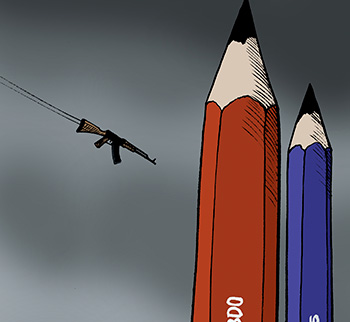“If political cartoonists are the foot soldiers of democracy, the ones at Charlie Hebdo were the advance guard in vigorously defending, with their last breath, one of the cardinal values of democracy: freedom of expression,” leading Israeli cartoonist Michel Kichka told The CJN in an interview last week.
“The Charlie Hebdo artists assassinated… by fanatical jihadists are great heroes. For editorial cartoonists, Charlie Hebdo represents the famous ‘red line’ that we aren’t supposed to cross. With their provocative drawings, Charb [Stephane Charbonnier], Cabu [Jean Cabut], [Georges] Wolinski, Tignous [Bernard Verlhac] defined and drew this red line every week without beating about the bush.”
A major political cartoonist and artist in Israel, Kichka was extremely upset about the Charlie Hebdo killings. Born in Belgium in 1954, Kichka, who made aliyah in 1974, grew up with the drawings of Cabu and Wolinski. Tignous was a close friend. Like Kichka, Tignous was a member of the organization Cartooning for Peace. Founded by Plantu, the renowned newspaper caricaturist for Le Monde, and former UN secretary general Kofi Annan, Cartooning for Peace includes artists from some 50 countries
.
Asked by Israeli TV and radio to comment on the attacks in France, Kichka struggled to explain to the Israeli public what the work of the Charlie Hebdo artists, who exemplify a longstanding French satirical tradition, represents. He also wrote an in-depth article on the subject, accompanied by a special cartoon, published in Yediot Achronot, Jan. 9.
“Unfortunately, we don’t have a satirical newspaper in Israel,” Kichka said in an interview from Jerusalem. “I explained that drawing the prophet Muhammad every morning isn’t what French artists do. In the ‘official’ French newspapers, you don’t draw Muhammad. Charlie Hebdo is a satirical paper that declared war on good taste and where there were never any limits or taboos. At Charlie Hebdo, they always stretched the boundaries more than at other publications. But that doesn’t mean French satirical newspapers are part of a marginal press.”
Satirical media, led in France by Charlie Hebdo, are “an excellent way of measuring the state of health of a democracy,” he said. “I think a healthy democracy must be able to accept things that are out of their control, including those that infringe on the law. At Charlie Hebdo, they make provocative statements every day. It’s the business of this vitriolic paper.”
Will the Charlie Hebdo attacks embolden other artists to cross the line?
“When you draw for Charlie Hebdo, you can produce very provocative drawings, even a little silly,” Kichka said. “But when you present those drawings in exhibitions organized by Cartooning for Peace, which go online on the organization’s website, you have to do ‘intelligent drawings,’ that is, drawings that you have given some thought to, being aware that the caricatures circulate on the Internet and are no longer confined to a small village in Denmark.”
For political cartoonists, Charlie Hebdo is “a kind of standard we refer to constantly,” Kichka stressed. “The artists at Charlie Hebdo make me ask myself questions about my own limits when I take up my pencil. Their invaluable work sometimes helps me see deep down that I can go further than I usually do, that maybe I hold myself back too much, that maybe it’s the Charlie Hebdo artists who are sometimes right. I also carry on a dialogue with myself comparing their work to mine. Then I tell myself, ‘This time, it was my colleagues at Charlie Hebdo who were right. Maybe I should have gone further.’ After all, drawing is a [form of] combat. You have to hit harder sometimes.”
Kichka teaches drawing at the Bezalel Academy of Arts and Design in Jerusalem. His cartoons on national and international events appear weekly on several popular Israeli public affairs TV shows. For several years, he chaired the Israeli Association of Caricaturists and Comic Artists.
Full French interview here. Carolan Halpern translation.
